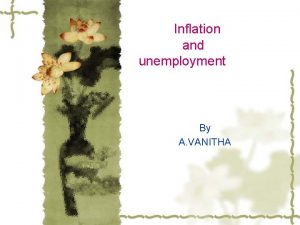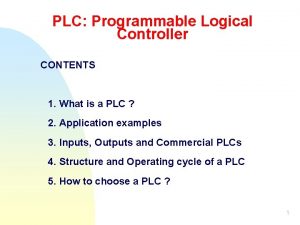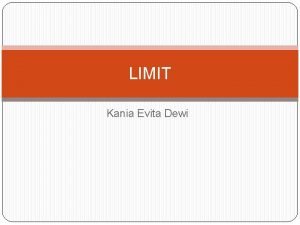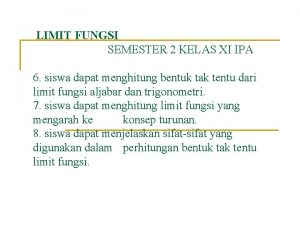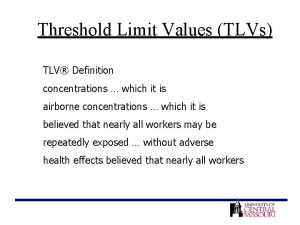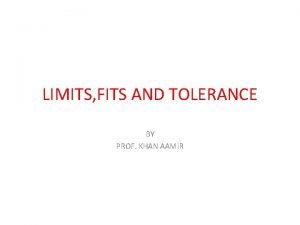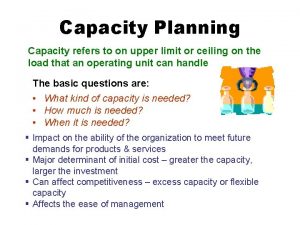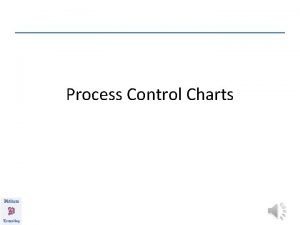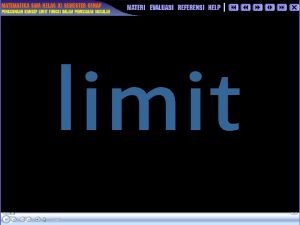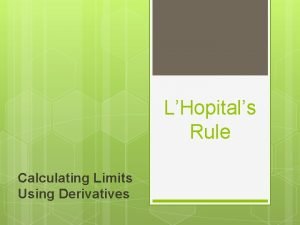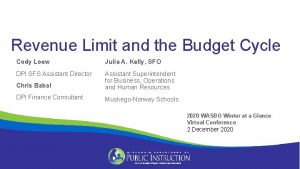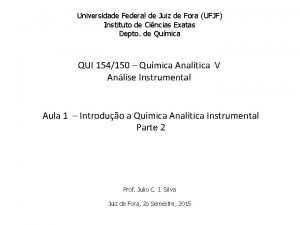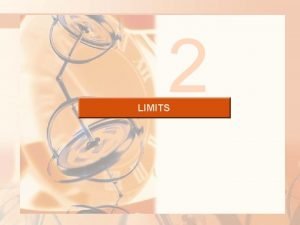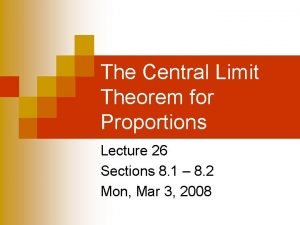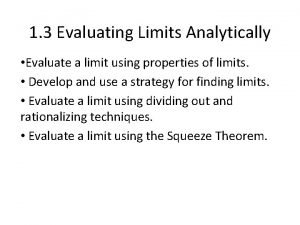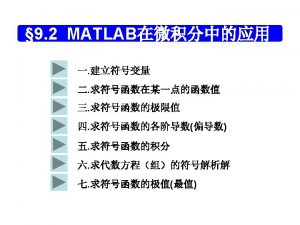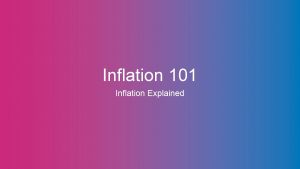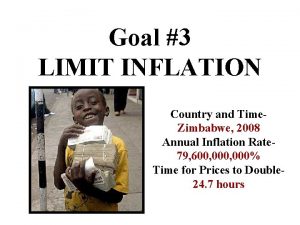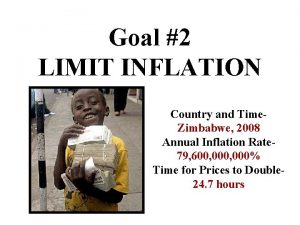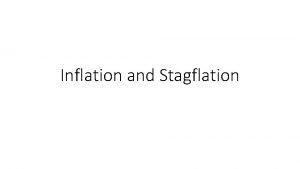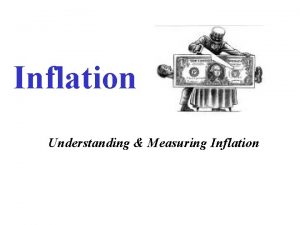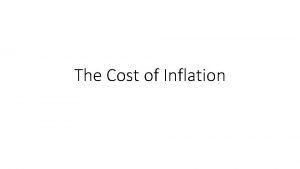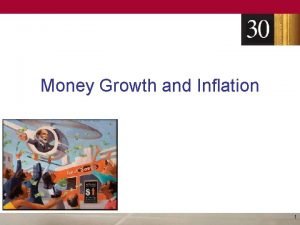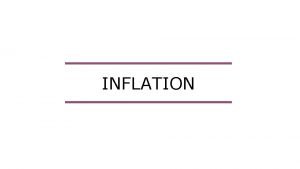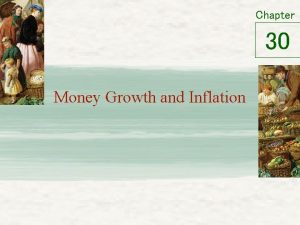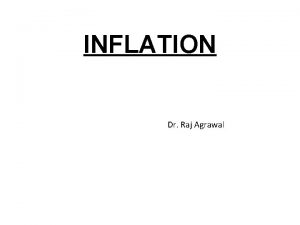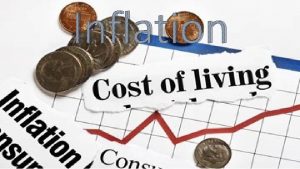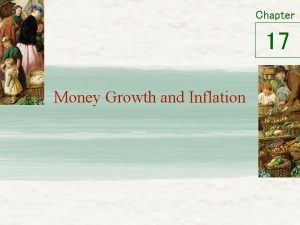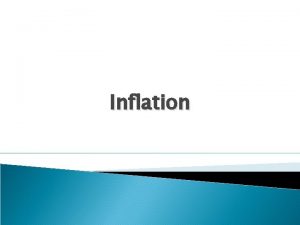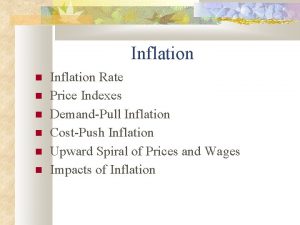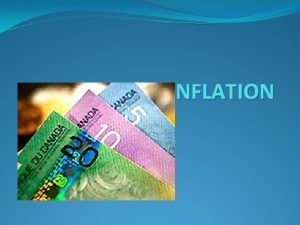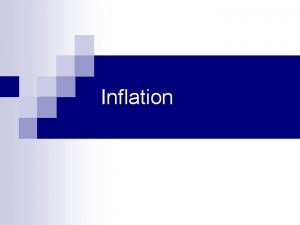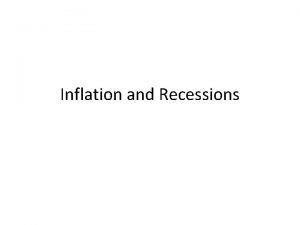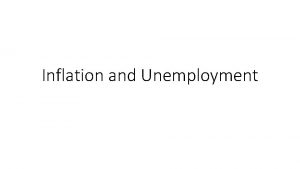Goal 2 LIMIT INFLATION What is Inflation Inflation













































- Slides: 45

Goal #2 LIMIT INFLATION

What is Inflation? Inflation is rising general level of prices and it reduces the “purchasing power” of money Examples: • It takes $2 to buy what $1 bought in 1987 • It takes $6 to buy what $1 bought in 1970 • It takes $24 to buy what $1 bought in 1913 When inflation occurs, each dollar of income will buy fewer goods than before

Is Inflation Good or Bad?

Good or Bad? In general, rapid inflation is bad because banks don’t lend and people don’t save. This decreases investment and GDP. What about deflation? Deflation- Decrease in general prices or a negative inflation rate. Deflation is bad because people will hoard money (financial assets) This decreases consumer spending and GDP. Disinflation- Prices increasing at slower rates

But inflation doesn’t effect everyone equally. Identify which people are helped and which are hurt by unanticipated inflation 1. A man who lent out $500 to his friend in 1960 and gets paid back in 2015. 2. A tenant who is charged $850 rent each year. 3. An elderly couple living off fixed retirement payments of $2000 a month 4. A man that borrowed $1, 000 in 1995 and paid it back in 2014. 5. A women who saved $500 in 1950 by putting it under her mattress

Effects of Unanticipated Inflation Hurt by Inflation • Lenders-People who lend money (at fixed interest rates) • People with fixed incomes • Savers Helped by Inflation • Borrowers-People who borrow money • A business where the price of the product increases faster than the price of resources Nominal Wage- Wage measured by dollars rather than purchasing power Real Wage- Wage adjusted for inflation If there is inflation, you must ask your boss for a raise


How is inflation measured? The government tracks the prices of specific “market baskets” that included the same goods and services. There are two ways to look at inflation over time: The Inflation Rate- The percent change in prices from year to year Price Indices- Index numbers assigned to each year that show prices have changed relative to a specific base year. Examples: • The U. S. inflation rate in 2014 was 0. 8%. • The Consumer Price Index for 2014 was 235 (base year 1982). This means that prices have increased 135% since 1982.

Consumer Price Index (CPI) The most commonly used measurement of inflation for consumers is the Consumer Price Index (CPI)

The Consumer Price Index, CPI, is a basket of goods and services purchased by the typical urban consumer. The CPI measures the “cost of living” by comparing the price of the market in the base year to all other years.

The CPI uses a market basket purchased by the typical urban consumer. The market basket is divided into eight categories. Those categories are: Housing 42% of the basket 2. Transportation 17% 3. Food and Beverages 15% 4. Medical Care 7% 5. Education and Communication 6% 6. Recreation 5% 7. Apparel 4% 8. Misc. 3% The following are some examples of items found in each of the categories of the CPI. This list is NOT exhaustive. It is only used to give a brief overview of some of the goods found in the basket…

Housing The CPI uses “equivalent rent” to compute housing prices. Equivalent rent is simply what homeowners would pay if they were renting their homes.

Transportation Some of the items placed in the CPI basket for transportation include spending on used and new cars, gasoline, and airline transportation

Food and Beverages The food and beverage category contains the types of foods and beverages the typical urban consumers purchases and also includes eating out

Healthcare (Medical) Some of the items placed in the CPI basket for health care includes spending on health insurance, glasses, and prescription drugs

Education and Communication Some of the items placed in the CPI basket for education and communication include spending for tuition, cell phone service, and computers 16

Recreation Some of the items placed in the CPI basket for recreation includes spending on books, bikes, and admission to concerts, etc.

Apparel Some of the items placed in the CPI basket for apparel includes spending on men's clothing and women's clothing 18

Miscellaneous Some of the items placed in the CPI basket for miscellaneous include haircuts and styling and tailoring services

So all the goods and services are added up and put in the market basket. Food and Beverages Healthcare (Medical) Transportation Housing Apparel Miscellaneous Education and Communication

What we do with the basket is compare it to the cost of the basket in other years. 2012: $7, 000 2013: $7, 500 2014: $8, 000

Remember that the CPI is an INDEX NUMBER so we need to convert the market basket price to an index number. To do this we must choose a base year to compare the cost of the other baskets to. Let’s use 2012 as the base year 2012: $7, 000

The formula for the CPI is simply: Current Year 100 Base Year

The formula for the CPI is simply: Current Year 100 Base Year

When the current year is the base year, the CPI is always 100. ($7, 000/$7, 000) x 100 = 100 Current Year $7, 000 100 Base Year $7, 000

Calculating the Index Number when the current year is 2013 (current year cost of market basket is $7, 500) ($7, 500/$7, 000) x 100 = 107. 14 Current Year $7, 500 100 Base Year $7, 000

Calculating the Index Number when the current year is 2014 (current year cost of market basket is $8, 000) ($8, 000/$7, 000) x 100 = 114. 28 Current Year $8, 000 100 Base Year $7, 000

Problems with the CPI 1. Substitution Bias- As prices increase for the fixed market basket, consumers buy less of these products and more substitutes that may not be part of the market basket. 2. New Products- The CPI market basket may not include the newest consumer products. 3. Product Quality- The CPI ignores both improvements and decline in product quality.

Calculating Nominal GDP, Real GDP, and Inflation

Calculating CPI Year 1 2 3 4 5 Nominal, Units of Price GDP Output Per Unit 10 10 15 20 25 Real, GDP CPI/ GDP Deflator (Year 1 as Base Year) $4 5 6 8 4 Make year one the base year CPI= Price of current basket x 100 Price of base year basket Inflation Rate

Calculating CPI Year 1 2 3 4 5 Nominal, Units of Price GDP Output Per Unit 10 10 15 20 25 $40 50 90 160 100 $4 5 6 8 4 Real, GDP CPI (Year 1 as Base Year) $40 40 60 80 100 125 150 200 100 Inflation Rate N/A 25% 20% 33. 33% -50% Inflation Rate % Change in Prices = New - Old X 100

Practice Year 1 2 3 4 5 Nominal, Units of Price GDP Output Per Unit 5 10 20 40 50 $6 8 10 12 14 $30 80 200 480 700 Real, GDP $50 100 200 400 500 Consumer Price Index (Year 3 as Base Year) 60 80 100 120 140 Make year three the base year Price of current basket CPI = Price of basket in base year x 100

CPI vs. GDP Deflator The GDP deflator measures the prices of all goods produced, whereas the CPI measures prices of only the goods and services bought by consumers. An increase in the price of goods bought by firms or the government will show up in the GDP deflator but not in the CPI. The GDP deflator includes only those goods and services produced domestically. Imported goods are not a part of GDP and therefore don’t show up in the GDP deflator.

2008 Audit Exam

2012 Audit Exam

Three Causes of Inflation

3 Causes of Inflation 1. The Government Prints TOO MUCH Money (The Quantity Theory) • Governments that keep printing money to pay debts end up with hyperinflation.

Why does printing money lead to inflation? Quantity Theory of Money Equation: Mx. V=Px. Q M = money supply V = velocity P = price level Q = quantity of output Notice that P x Q is Nominal GDP

Mx. V=Px. Q Why does printing money lead to inflation? • Assume the velocity is relatively constant because people's spending habits are not quick to change. • Also assume that output (Q) is not affected by the amount of money because it is based on production, not the value of the stuff produced. If the govenment increases the amount of money (M) what will happen to prices (P)? Ex: Assume money supply is $5 and it is being used to buy 10 products with a price of $2 each. 1. How much is the velocity of money? 2. If the velocity and output stay the same, what will happen if the amount of money is increase to $10? Notice, doubling the money supply doubles prices

2012 Audit Exam

3 Causes of Inflation 2. Demand- Pull Inflation DEMAND PULLS UP PRICES!!! “Too many dollars chasing too few goods” An overheated economy with excessive spending but same amount of goods. 3. Cost-Push Inflation Higher production costs increase prices A negative supply shock increases the costs of production and forces producers to increase prices.

Nominal vs. Real Interest Rates

Interest Rates and Inflation What are interest rates? Why do lenders charge them? If the nominal interest rate is 10% and the inflation rate is 15%, how much is the REAL interest rate? Real Interest Rates. The percentage increase in purchasing power that a borrower pays. (adjusted for inflation) Real = nominal interest rate - expected inflation Nominal Interest Ratesthe percentage increase in money that the borrower pays not adjusting for inflation. Nominal = Real interest rate + expected inflation

Nominal vs. Real Interest Rates Example #1: You lend out $100 with 20% interest. Inflation is 15%. A year later you get paid back $120. What is the nominal and what is the real interest rate? Nominal interest rate is 20%. Real interest rate was 5% In reality, you get paid back an amount with less purchasing power.

Nominal vs. Real Interest Rates Example #2: You lend out $100 with 10% interest. Prices are expected to increased 20%. In a year you get paid back $110. What is the nominal and what is the real interest rate? Nominal interest rate is 10%. Real rate was – 10% In reality, you get paid back an amount with less purchasing power.
 Cara menggambar grafik limit
Cara menggambar grafik limit If lclp is negative number, we set the lclp = 0. why?
If lclp is negative number, we set the lclp = 0. why? Limites de control
Limites de control Types of unemployments
Types of unemployments How to find the limit of a series
How to find the limit of a series Logical controller
Logical controller Pengertian limit fungsi secara intuisi
Pengertian limit fungsi secara intuisi Sifat limit tak hingga
Sifat limit tak hingga Absolute speed limit definition
Absolute speed limit definition Fundamental trigonometric limit
Fundamental trigonometric limit Apa itu tlv
Apa itu tlv Limit suppliers in selection pool
Limit suppliers in selection pool Types of fits
Types of fits Diary entry word limit
Diary entry word limit Capacity refers to
Capacity refers to Vex testbed
Vex testbed Landing climb limit weight
Landing climb limit weight Upper and lower control limit formula
Upper and lower control limit formula Dengan teorema limit hitunglah lim (x+4)(x2+3x-5)
Dengan teorema limit hitunglah lim (x+4)(x2+3x-5) Diary entry word limit
Diary entry word limit Limit cycle oscillation in dsp
Limit cycle oscillation in dsp Extension load graph hooke's law
Extension load graph hooke's law Deep learning for limit order books
Deep learning for limit order books Trigger limit cycle
Trigger limit cycle Betz limit
Betz limit Limit set
Limit set Plastic limit
Plastic limit Limit to infinity rule
Limit to infinity rule Dpi revenue limit worksheet
Dpi revenue limit worksheet Closure of a set
Closure of a set Hardware address protection with base and limit registers
Hardware address protection with base and limit registers Lane positions
Lane positions Cat cable speeds chart
Cat cable speeds chart Fname
Fname Serviceability limit state
Serviceability limit state Minimos quadrados
Minimos quadrados Consistency limits and indices
Consistency limits and indices Squeeze theorem calculator
Squeeze theorem calculator How big is jupiter's red spot
How big is jupiter's red spot The central limit theorem for proportions
The central limit theorem for proportions Dse english writing text types
Dse english writing text types Cima existing requirements
Cima existing requirements How to find limits analytically
How to find limits analytically Limit of economic haul formula
Limit of economic haul formula Rules of central limit theorem
Rules of central limit theorem Ncbr limit 276 godzin
Ncbr limit 276 godzin



